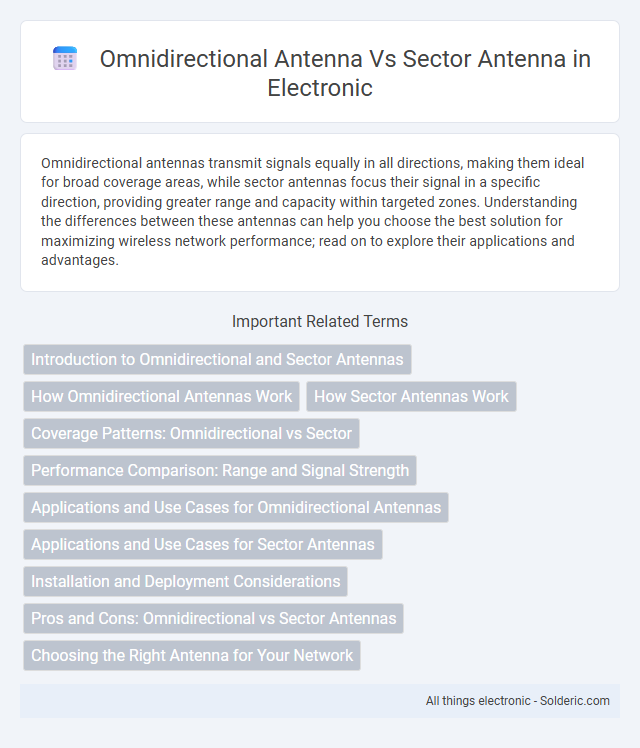Omnidirectional antennas transmit signals equally in all directions, making them ideal for broad coverage areas, while sector antennas focus their signal in a specific direction, providing greater range and capacity within targeted zones. Understanding the differences between these antennas can help you choose the best solution for maximizing wireless network performance; read on to explore their applications and advantages.
Comparison Table
| Feature | Omnidirectional Antenna | Sector Antenna |
|---|---|---|
| Coverage Pattern | 360deg horizontal coverage | 60deg to 120deg directional coverage |
| Use Case | Wide area broadcasting, general coverage | Focused coverage, cellular base stations |
| Gain | Low to moderate (2-8 dBi) | Moderate to high (10-15 dBi) |
| Range | Short to medium range | Medium to long range |
| Interference | Higher susceptibility due to omnidirectional pattern | Lower interference with targeted transmission |
| Installation | Simple, single antenna covers all directions | Requires multiple antennas for full coverage |
| Application Examples | Wi-Fi hotspots, base stations in open areas | Cellular sectorized sites, point-to-multipoint links |
Introduction to Omnidirectional and Sector Antennas
Omnidirectional antennas transmit and receive signals uniformly in all horizontal directions, providing 360-degree coverage ideal for broad area networks and mobile devices. Sector antennas focus radio signals into specific segments, typically covering 60 to 120 degrees, offering higher gain and better performance for targeted coverage in wireless networks like cellular and Wi-Fi systems. The choice between omnidirectional and sector antennas depends on coverage requirements, signal strength, and network design goals.
How Omnidirectional Antennas Work
Omnidirectional antennas transmit and receive signals uniformly in all horizontal directions, creating a 360-degree coverage area ideal for environments requiring broad, consistent connectivity. They employ vertically polarized elements that radiate radio waves outward in a donut-shaped pattern, maximizing signal dispersion over a wide area. This characteristic makes omnidirectional antennas suitable for applications like Wi-Fi access points and cellular base stations where coverage in multiple directions is essential.
How Sector Antennas Work
Sector antennas work by dividing their coverage area into specific angular sectors, typically ranging from 60 to 120 degrees, allowing targeted signal transmission and reception within those focused regions. Unlike omnidirectional antennas that radiate signals uniformly in all directions, sector antennas enhance performance by directing radio waves towards selected sectors, improving signal strength and reducing interference. You can optimize network capacity and coverage by strategically deploying sector antennas to manage traffic efficiently within distinct geographic zones.
Coverage Patterns: Omnidirectional vs Sector
Omnidirectional antennas provide a 360-degree horizontal coverage pattern, making them ideal for broadcasting signals uniformly in all directions, which suits environments requiring broad area coverage. In contrast, sector antennas deliver focused coverage within a specific angular range, typically 60 to 120 degrees, enabling higher gain and improved signal strength within targeted zones. This directional focus reduces interference and increases capacity in dense network deployments by concentrating energy toward intended users.
Performance Comparison: Range and Signal Strength
Omnidirectional antennas provide 360-degree coverage, making them ideal for broad area coverage but often sacrifice range and signal strength compared to sector antennas. Sector antennas focus their signal in a specific direction, resulting in enhanced range and stronger signal performance within that targeted area. Your choice depends on whether you prioritize widespread coverage or concentrated, high-strength signal transmission.
Applications and Use Cases for Omnidirectional Antennas
Omnidirectional antennas are widely used in applications requiring 360-degree coverage, such as Wi-Fi access points, cellular base stations, and public safety communications to provide uniform signal distribution in all directions. These antennas excel in environments with multiple users spread across a circular area, including urban parks, stadiums, and large indoor spaces. Their ability to maintain consistent connectivity makes them ideal for mobile devices and IoT networks where seamless coverage and reliability are critical.
Applications and Use Cases for Sector Antennas
Sector antennas deliver targeted wireless coverage ideal for outdoor environments and large public venues such as stadiums, campuses, and city-wide Wi-Fi networks. Their focused beamwidth supports high-capacity, point-to-multipoint communication, making them optimal for cellular base stations and fixed wireless access points. These antennas enhance network performance by reducing interference and increasing signal range within defined sectors.
Installation and Deployment Considerations
Omnidirectional antennas provide 360-degree coverage, making them easier to install on central poles or rooftops without precise alignment, ideal for open areas requiring broad signal distribution. Sector antennas require careful directional installation with specific azimuth and tilt angles to optimize coverage sectors, often used in cellular networks to target defined areas and reduce interference. Deployment of sector antennas demands detailed site surveys and alignment tools, while omnidirectional antennas offer quicker deployment with less technical complexity.
Pros and Cons: Omnidirectional vs Sector Antennas
Omnidirectional antennas provide 360-degree coverage, ideal for broad, uniform signal distribution, but they may suffer from interference and reduced range in specific directions. Sector antennas focus signals within a specific angle, offering higher gain and better performance over longer distances, yet their coverage is limited to a defined sector, requiring multiple units for full area coverage. Choosing between these depends on your network layout, coverage needs, and interference management priorities.
Choosing the Right Antenna for Your Network
Omnidirectional antennas provide 360-degree coverage, making them ideal for environments needing broad, uniform signal distribution, while sector antennas focus signal strength in specific directions, offering higher gain and better performance over limited areas. Your choice depends on network goals: use omnidirectional antennas for central locations requiring widespread coverage and sector antennas for targeting distinct zones with increased capacity. Evaluating factors like coverage area size, interference levels, and user density ensures the right antenna enhances your network's efficiency and reliability.
omnidirectional antenna vs sector antenna Infographic

 solderic.com
solderic.com